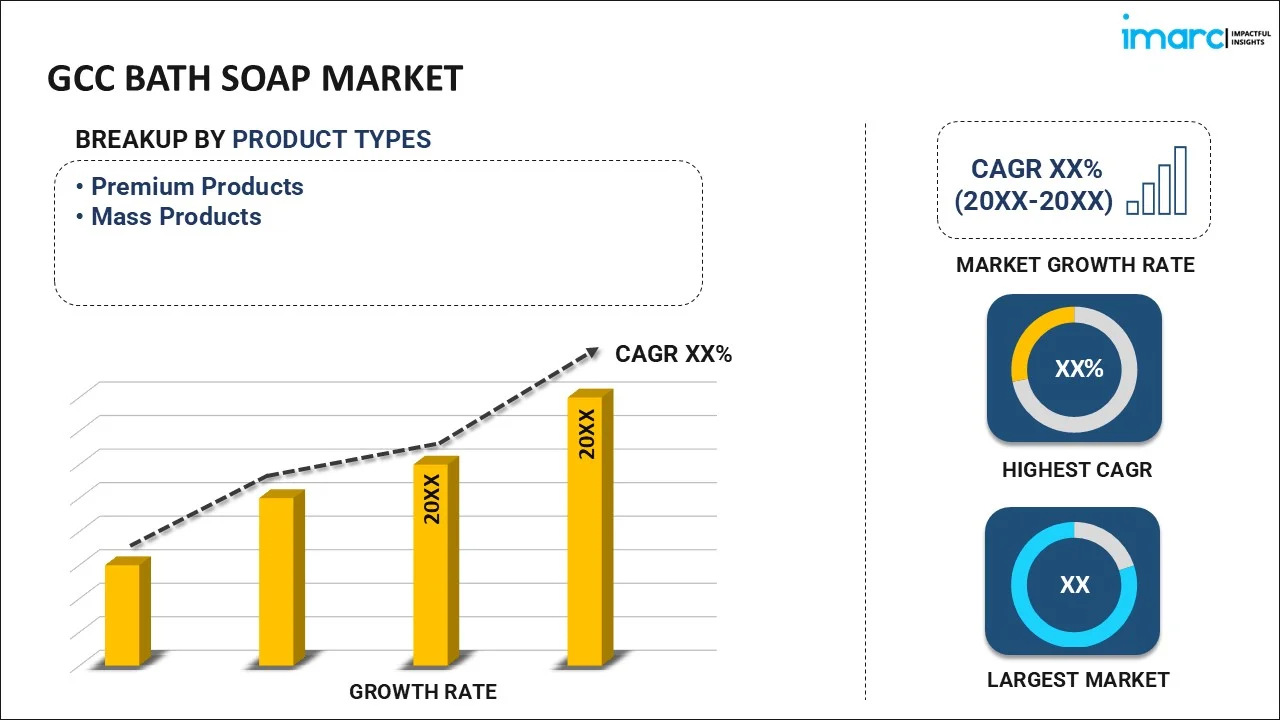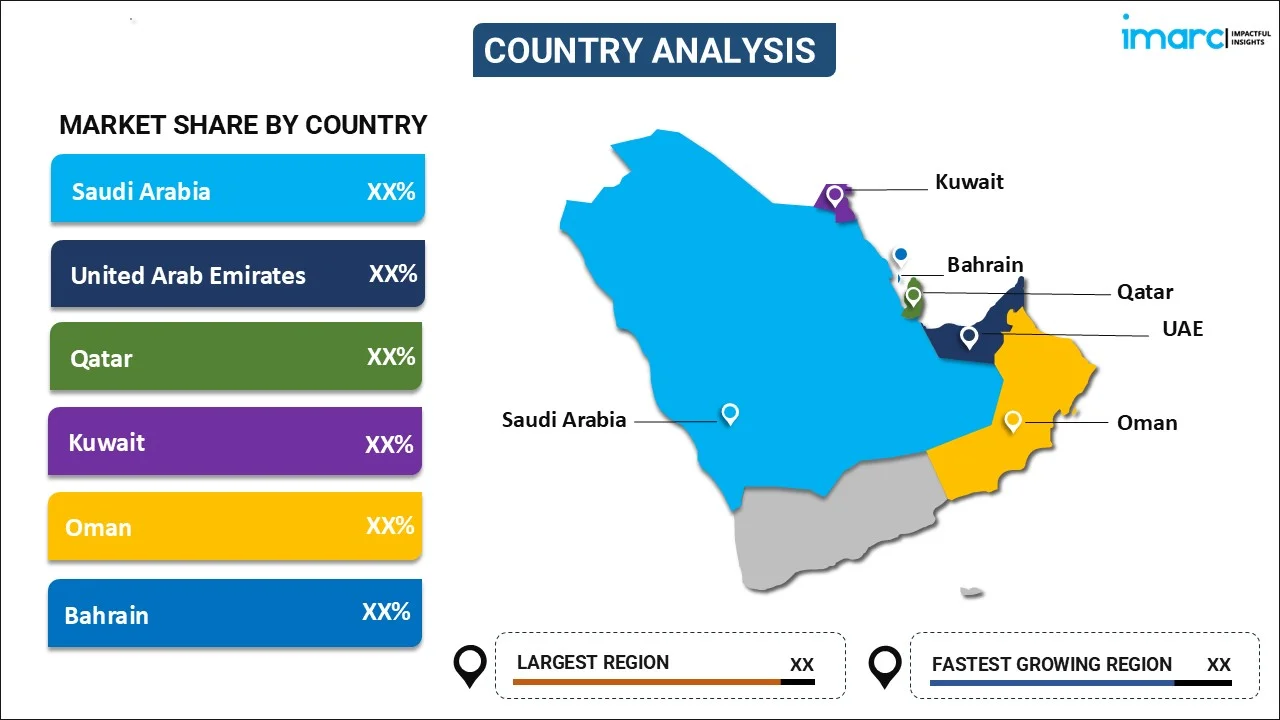
GCC Bath Soap Market Report by Product Type (Premium Products, Mass Products), Form (Solid Bath Soaps, Liquid Bath Soaps), Distribution Channel (Supermarkets and Hypermarkets, Convenience Stores, Pharmacies, Specialty Stores, Online, and Others), and Country 2025-2033
Market Overview:
The GCC bath soap market size reached USD 541.2 Million in 2024. Looking forward, IMARC Group expects the market to reach USD 825.3 Million by 2033, exhibiting a growth rate (CAGR) of 4.4% during 2025-2033.
|
Report Attribute
|
Key Statistics
|
|---|---|
|
Base Year
|
2024
|
|
Forecast Years
|
2025-2033
|
|
Historical Years
|
2019-2024
|
|
Market Size in 2024
|
USD 541.2 Million |
|
Market Forecast in 2033
|
USD 825.3 Million |
| Market Growth Rate 2025-2033 | 4.4% |
Bath soaps are salts of fatty acids that are used for cleansing purposes. They are commercially available in bar, powder, flakes, and liquid forms. Bath soaps are made from a combination of alkalis, such as caustic lye, with vegetable or animal oil extractions. Some other ingredients include glycerin, propylene glycol, allantoin, and triethanolamine. These elements undergo the saponification process to neutralize the lye and help with lathering. Bath soap molecules repel dirt and emulsify oil, which aids in unclogging pores, conditioning the skin, preventing acne, and keeping the surface moisturized.
GCC Bath Soap Market Trends:
Rapidly increasing population, rising hygiene awareness, and changing consumer preferences are majorly driving the GCC bath soap market growth. This, in turn, has prompted manufacturers to formulate new products catering to different skin types in a wide variety of shapes and sizes. Other than this, the introduction of premium, multifunctional, and value-added products, such as bubble, moisturizing, and scented bath soaps, are further inflating product sales across the region. Moreover, the availability of the product in attractive, single- or multi-packs made from biodegradable materials to reduce carbon footprint are acting as a growth-inducing factor. The escalating demand for bath soaps can also be attributed to the launch of eco-friendly bath soaps containing natural ingredients, such as sea salt, aloe vera, and honey, that are gentler and prevent adverse chemical reactions on the skin. Some of the other factors, including aggressive marketing techniques, inflating income levels, and rapid establishment of supermarkets, are creating a positive outlook for the market across the region.
Key Market Segmentation:
IMARC Group provides an analysis of the key trends in each sub-segment of the GCC bath soap market report, along with forecasts at the regional and country level from 2025-2033. Our report has categorized the market based on product type, form and distribution channel.
Breakup by Product Type:

- Premium Products
- Mass Products
Breakup by Form:
- Solid Bath Soaps
- Liquid Bath Soaps
Breakup by Distribution Channel:
- Supermarkets and Hypermarkets
- Convenience Stores
- Pharmacies
- Specialty Stores
- Online
- Others
Breakup by Country:

- Saudi Arabia
- UAE
- Qatar
- Oman
- Kuwait
- Bahrain
Competitive Landscape:
The competitive landscape of the industry has also been examined along with the profiles of the key players.
Report Coverage:
| Report Features | Details |
|---|---|
| Base Year of the Analysis | 2024 |
| Historical Period | 2019-2024 |
| Forecast Period | 2025-2033 |
| Units | Million USD |
| Segment Coverage | Product Type, Form, Distribution Channel, Country |
| Region Covered | Saudi Arabia, UAE, Qatar, Oman, Kuwait, Bahrain |
| Customization Scope | 10% Free Customization |
| Post-Sale Analyst Support | 10-12 Weeks |
| Delivery Format | PDF and Excel through Email (We can also provide the editable version of the report in PPT/Word format on special request) |
Key Questions Answered in This Report
We expect the GCC bath soap market to exhibit a CAGR of 4.4% during 2025-2033.
The introduction of bath soaps in single- or multi-packs that are produced by using biodegradable materials to reduce carbon footprint is primarily driving the GCC bath soap market.
The sudden outbreak of the COVID-19 pandemic has led to the changing consumer inclination from conventional brick-and-mortar distribution channels towards online retail platforms for the purchase of bath soaps across several GCC nations.
Based on the product type, the GCC bath soap market can be categorized into premium products and mass products. Currently, mass products account for the majority of the total market share.
Based on the form, the GCC bath soap market has been segregated into solid bath soaps and liquid bath soaps, where solid bath soaps currently exhibit a clear dominance in the market.
Based on the distribution channel, the GCC bath soap market can be bifurcated into supermarkets and hypermarkets, convenience stores, pharmacies, specialty stores, online, and others. Among these, convenience stores hold the largest market share.
On a regional level, the market has been classified into Saudi Arabia, UAE, Qatar, Oman, Kuwait, and Bahrain, where Saudi Arabia currently dominates the GCC bath soap market.
Need more help?
- Speak to our experienced analysts for insights on the current market scenarios.
- Include additional segments and countries to customize the report as per your requirement.
- Gain an unparalleled competitive advantage in your domain by understanding how to utilize the report and positively impacting your operations and revenue.
- For further assistance, please connect with our analysts.

 Inquire Before Buying
Inquire Before Buying
 Speak to an Analyst
Speak to an Analyst
 Request Brochure
Request Brochure
 Request Customization
Request Customization



.webp)




.webp)












